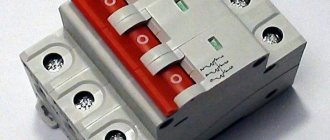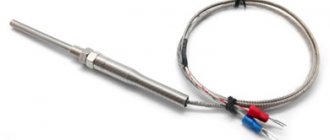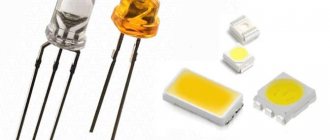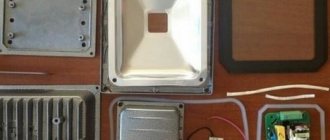Purpose and principle of operation of a lux meter
The main purpose of the device is to measure the level of illumination at the required point in space.
Where a lux meter is used, you can easily adjust this indicator, which depends on:
- number of light sources, including artificial and natural;
- light pressure of each source;
- distance between the measurement point and the light source;
- reflectivity of nearby surfaces.
The device is actively used in the following cases:
- To control sanitary standards for lighting in residential premises.
- To measure the level of illumination of workplaces, which allows maintaining comfortable working conditions and hygiene for workers.
- To control the illumination of premises in production areas, schools, libraries, medical institutions, museums, etc.
- For selecting the brightness of lamps in greenhouses and greenhouse farms where plants are bred and maintained.
- To determine the shooting exposure when taking photographs.
- To adjust the brightness of signal lights and illuminated advertising.
- As part of a pulse meter-brightness meter - to measure the degree of pulsation of the image of monitors and illumination in general, caused by the flickering of LEDs, fluorescent and energy-saving lamps.
- To check whether the actual illumination corresponds to the calculated level when installing lighting systems.
When the device operates, a luminous flux of a certain spectrum is converted into an electric current with the corresponding intensity characteristics of the first.
The results are displayed on the device screen.
Given how a lux meter works, it makes sense to use models that allow you to select the operating mode for a specific light spectrum.
Operating principle of the device:
• The electrons in a photocell made from a semiconductor are activated by light. The brighter the light flux, the more actively electrons are released.
• The throughput of the photocell changes, which is recorded by the electronics of the device, which, after processing by the processor, is displayed on the screen.
• The illumination meter in operation produces results, the correctness of which depends on the correct orientation of the sensor relative to the light flux.
What is a lux meter
Translated from Greek, the name consists of two words “light” and “measure”. The device is used to check the level of illumination. This is a photometer, but it can also be used to control other criteria: light brightness, pulsation coefficient, it all depends on the model. Most often it is used for the following purposes:
- Checking the quality of lighting in order to add luminaires or move them to another location if required.
- Monitoring compliance of indicators with regulations. This is necessary in offices, industrial premises, educational and preschool institutions.
- Selection of lighting mode in places where precision work is performed.
- Checking the performance of light sources in greenhouses and conservatories.
- Selecting the operating mode of outdoor advertising, signal lighting, etc.
By the way! The device helps you quickly select the exposure during a photo shoot.
Device and characteristics
The main element of a luxmeter is a semiconductor photocell that transfers the energy of light quanta to electrons.
The resulting electrical flow, depending on the type of device, is either converted by a galvanometer, provoking the movement of the pointer needle, or transformed by an optical-electronic converter into digital form, followed by display of the result on the display.
In other words, a classic lux meter consists of a converter and a photosensor, which can be made as a monoblock or as separate modules connected by wire.
Illumination levels are measured in lux, and the emission scale ranges from a tenth to several hundred thousand.
In this case, 1 lux corresponds to illumination of 1 lumen over an area of 1 square meter.
Accordingly, the unit of measurement of a light meter is lux, and lumens indicate the intensity of the light flux.
Material
The body of the portable device is made of durable and reliable plastic material.
For ease of holding, some models have rubberized pads.
In the case of a separate layout, the photo sensors are also hidden by a plastic housing.
Dimensions and weight
The weight of most portable light meters is 0.1 - 0.5 kg, depending on the size of the battery.
Approximate dimensions of devices:
- height: 80 – 200 mm (depending on the layout);
- width: 50 – 80 mm.
Accuracy, error and verification
The state verification scheme for lux meters is fully described in GOST 8.023-2014.
The initial verification of instruments included in the State Register of SI of the Russian Federation is carried out after their repair, or immediately before commissioning.
Periodic verification in most cases is performed once a year.
Includes checking the accuracy and all errors of the device.
Calibration, among other things, implies spectral correction of its photosensor.
Types of lux meters and their prices
Lux meters can be used for their intended purpose both outdoors and indoors.
Structurally, they are divided into:
• Monoblocks – the sensor is fixed directly to its body. This option is convenient for making quick measurements, has less weight, however, it is not suitable for working in hard-to-reach places. Some models have a removable sensor, which expands their functionality.
• With a remote sensor – a more convenient option for taking measurements in places where it is difficult to get to. The sensitive sensor is connected to the main module with a flexible wire, which allows you to easily measure indicators from any direction. Such lux meters are preferable when assessing working conditions.
Depending on the type of indicator, devices are:
• Digital. The measurement results are displayed electronically on the device display. Such lux meters are easy to use and have relatively high accuracy.
• Pointer – the analog indicator has a pointer and a scale, the gradation of which is made in lux. The accuracy of the measurement indicators, compared to the previous version, is significantly lower.
The lux meter can have expanded functionality; according to its characteristics, the device can be:
• Household. Cheap models display only illumination; they are used for quick measurements that do not require high accuracy. More expensive options are capable of independently calculating the average illumination value based on several measurements. The design provides internal memory and an interface for connecting the device to a personal computer or laptop. The minimum price for the device is 1500 rubles.
• Professional – equipped with light filters, the spectral sensitivity of the photosensor, which is almost similar to the human eye. They make it possible to more effectively measure the properties of light fluxes of various color shades. Outdoor models are additionally equipped with special absorption filters that expand the measuring range in bright light. The measurement error is about 1%. The cost of professional models starts at 10 thousand rubles.
Often, professional lux meters are equipped with additional equipment that allows them to measure other characteristics of the luminous flux:
• Luxmeter-brightness meter. In addition to performing the functions of a lux meter itself, it is designed to measure the brightness of luminous objects. A high-quality device will cost 10 thousand or more rubles.
• Light meter-pulse meter. This device, in addition to measuring illumination, is capable of determining the pulsation (flicker) coefficient of computer monitors, tablet screens, phones, and other devices. Lux meters with pulsation measurements will help you choose, for example, a lamp with flicker indicators that are safest for the human eye. The minimum cost is 4.5 thousand rubles.
• Universal measuring instruments that simultaneously perform the functions of a lux meter, brightness meter and pulse meter. The cost of good models with verification starts from 15 thousand rubles.
The price of lux meters greatly depends on the operating ranges.
For this reason, higher-quality target devices with a narrow measuring range will cost more than their Chinese counterparts “for all occasions.”
As an alternative to a lux meter, special applications installed on iOS or Android can serve.
However, many tests carried out give the same results: a lux meter in a smartphone is not able to replace a full-fledged device, as it has a large error, the magnitude of which depends on the phone model.
How to use a lux meter?
You can quickly and safely find the desired measurement range for a photodetector if you act in a certain sequence:
- Automatic wrist blood pressure monitor JZK-002R
- Install attachments with maximum light absorption (K and T) on the photodetector, turn on the right button, which corresponds to measuring the maximum illumination - 100,000 lux. If the measuring needle does not respond, turn on the left one (up to 30,000 lux).
- If the arrow does not move, replace the filter with a more transparent one (P) and turn it on in the same sequence: first the right button, then the left one.
- If there is no movement, install a soft filter (M) and perform similar manipulations.
- If in this case, when the left button is pressed, the result is less than 5 lux, remove the base attachment K and end the search.
To move the measured value away from the area of overlap of the two scales (in the region of 5–20 divisions), it is recommended to start counting the measurement from 5 divisions on the inner scale, or from 20 on the outer scale. For this purpose, reference points are marked on the scales.
Remember: excessive illumination of the selenium photosensor may affect the accuracy of the measurements, so follow the given sequence of actions.
Which lux meter is better and how to choose it?
Choosing a lux meter begins with setting the right tasks that this measuring device should solve.
Criteria to follow:
• Operating range and spectral sensitivity. Each device is capable of working only with a certain type of radiation, for example, ultraviolet, or light from neon lamps. There are universal devices where a special switch is provided to set the measurement interval. The overload indicator will allow you to determine whether the measurement range has been exceeded.
• Additional functions. Some models, in addition to working with light flux, are capable of measuring ambient temperature, noise level and even air pressure. The price tag for such variants of devices is noticeably higher, however, one such device can replace several different types of meters at once, the total cost of which individually will be even higher.
• Dimensions. Portable devices that fit easily in one hand are much more convenient to use.
• Screen. Its size directly affects the ease of reading data. The display backlight, if provided, will allow you to work with the lux meter in low light conditions.
• Nutrition. Preference should be given to devices with an autonomous power supply, since it will allow measurements to be taken in absolutely any conditions, regardless of the presence of a household network.
• PC connection. For professional devices, such a function is mandatory.
If you need to carry out operational measurements, for example, when setting up lighting systems, it is enough to have a good inexpensive monoblock light meter on hand.
Its resources will be sufficient to carry out inspections.
If it is necessary to assess working conditions, professional models with a remote sensor will be more effective, since they have higher measurement accuracy and less error.
Often, such lux meters are equipped with built-in memory and can store measurement results.
Attention!
When purchasing a lux meter, you should definitely pay attention to its passport, where all the features of the device are fully indicated.
In addition, if professional use is planned, it must be included in the State Register, which guarantees compliance with all declared technical characteristics.
Luxmeter: why is it needed and where is it used
Lux is a unit in which the level of illumination is measured. It can be very different! For example, on a full moon, when the sky is clear, the illumination indicator will be 0.27 lux, and on a bright noon - 130 thousand lux (Lux).
Why know the light level? There is a corresponding SNiP, which states that in an office workplace, the level of artificial lighting should be from 200 to 300 lux. Otherwise, people will feel uncomfortable, their productivity will drop, and their eyes will quickly get tired.
It is also very important to adhere to lighting standards in hospitals, educational and children's institutions, research centers, libraries, and museums. It is precisely in order to comply with SNiP standards and ensure comfort in such public and work areas that a lux meter is simply necessary.
Important! A lux meter is a type of photometer. This is a portable device that measures the level of illumination in lux.
Simple lux meters consist of a selenium photocell. It converts the light flux into electric current energy, and then measures the photocurrent on a scale in lux. Higher-end lux meters have a light filter that increases the sensitivity of the photocell to approximately the same level as the human eye. In addition, modern instruments have an attachment to reduce errors in oblique light, a control attachment to check sensitivity, and a light-absorbing attachment to measure very high light levels.
A modern lux meter is always a portable, small device, the indicators are displayed on a liquid crystal screen, the measuring part for measuring the level of illumination in hard-to-reach places is attached to the body with flexible wires.
In everyday life, complex, professional lux meters, whose price can exceed 20 thousand rubles, are not needed! A simple device with a measuring part attached to the body will be sufficient. The price of such models is about 1.5 thousand rubles.
Why do owners of a house or apartment need a household lux meter?
- Measure the light level in your home office or where your child does homework. It often turns out that general lighting is not enough; another lamp with a brighter, directional light is needed on a desk or computer desk;
- To ensure the proper level of illumination in the workshop, in the needlewoman’s corner;
- To compare different lighting fixtures to make the right choice;
- To provide the most comfortable conditions for indoor plants and seedlings. As the portal Rmnt.ru already wrote in an article about phytolamps, different plants need different luminous fluxes and in winter, backlighting may be a necessity;
- To care for the inhabitants of aquariums, which also need light;
- To check real technical readings of video cameras and cameras.
According to experts, you don't need to be a professional to use modern electronic light meters. You just need to horizontally place the measuring part of the device in the place whose illumination level you want to know, and point it towards the light source. For example, put it on a desk or computer desk, a windowsill where there are seedlings, and so on. Then you need to press the corresponding button on the case and read the indicators from the screen.
Important! Many modern lux meters have an additional function - they measure pulsation, that is, the unevenness of the light flux. A variety of lighting fixtures, monitors, displays can pulsate... Meanwhile, there are strict standards, according to SanPiN, light pulsation in a living room should not exceed 10%, in the workplace in front of a computer monitor - 5%.
We state: for everyday use, an inexpensive lux meter without additional functions is quite sufficient. Choose portable models with a large enough display, simple controls and menus. Don't forget to read the instructions! Professionals choose light heart rate monitors with the ability to connect to a PC, additional attachments and built-in memory.
What you need to know about lux meters?
When taking measurements with a lux meter, it is important to know about some features of its operation:
- If analog measuring equipment is used, then the needle must be at zero before taking measurements.
- If the device shows illumination less than 30 lux, and photocell attachments are used, measurements should be continued without them.
- Movements of the device directly during the measurement process create additional errors.
- Extraneous light sources can significantly distort measurement results.
Due to the high cost of professional lux meters, it is not practical to buy them for single measurements.
It is more profitable to rent the device for the required time from specialized companies that sell geodetic and control equipment.
Models provided by such companies always have up-to-date verification.











